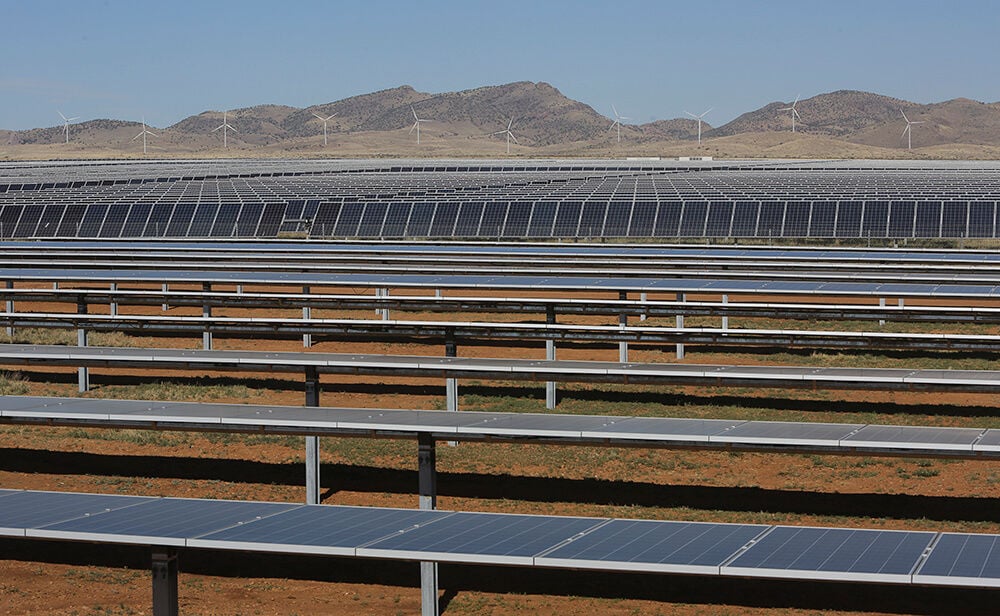Tucson Electric Power Co. says a proposed state policy requiring utilities to generate 80 percent of their power from renewable sources by 2050 is doable but would raise costs for the company and its ratepayers by more than $800 million through 2030.
The plan would also prompt the eventual closure of generating units owned by TEP at the Springerville Generating Station, the company said in regulatory filings.
Arizona Corporation Commission member Andy Tobin has proposed a statewide “energy modernization plan” that would require that clean energy sources make up at least 80 percent of the state’s electricity generating portfolio by 2050, with an ultimate goal of 100 percent.
The plan would encourage the development of renewable generating plants with energy storage and count energy from Arizona Public Service’s Palo Verde Nuclear Generating Station as clean energy.
Tobin has asked the commission to take up the matter for discussion and a possible vote at its next regular open meeting on Thursday, July 19, when the utility panel is also expected to again consider TEP’s proposed rate plans for customers with new rooftop solar systems.
But neither item was on an initial open meeting agenda posted Thursday.
TEP generally backs the energy modernization plan’s broader objectives, but much work remains to be done, spokesman Joe Barrios said.
“Broadly speaking, we support the plan’s principles and objectives and we believe it’s achievable, even if more study and discussion is needed to identify the specific requirements,” Barrios said.
“It’s important to consider that we’re already pursuing our own clean energy goals that will exceed existing state requirements.
“We’re in favor of coordinated, integrated resource energy policies overseen by elected officials that will bring more clean energy to our community.”
The plunging costs of renewable energy and competition from cheap natural gas already has made it difficult for operators of coal and nuclear plants to fully recover their cost of operations, TEP says.
In filings with the Corporation Commission, TEP said that if the Corporation Commission adopts the higher mandate, TEP’s total revenue requirements would increase by about $804 million between 2018 and 2030.
Barrios said estimates on the impact on customer bills were not yet available.
The higher costs would mainly include an additional $673 million in investments in energy-storage systems and about $53 million for new biomass energy projects, which burn forest waste to generate power.
Nuclear energy generation is considered a “carbon-free” energy source, though critics say it’s far from clean because of the problem of disposing of toxic radioactive waste.
Biomass proponents say it is “carbon neutral” because wood products eventually release carbon dioxide whether they are burned or simply decompose, completing a natural carbon cycle, though some scientists say it should not be considered clean because of other emissions.
TEP also says the plan would force the utility to retire the Unit 1 generator at the coal-fired Springerville power plant near Page by 2035 and retire Unit 2 by 2040 to make room for renewable capacity to meet compliance targets in the proposed plan.
That would result in the loss of about 765 jobs and $151 million in gross state product in Apache County alone, the utility said.
TEP noted in its filings that it is ramping up large-scale energy storage, which can be used to store solar and other renewable energy for use during periods of peak demand.
The utility has 21 megawatts of battery energy storage currently operating, and has contracted for 30 MW of four-hour battery storage as part of a 100 MW solar farm slated to reach commercial operation in late 2020.
TEP says it is also considering purchasing or contracting for up to 200 MW of the proposed Big Chino Valley pumped-storage hydro project north of Prescott, which is expected to be online in 2025.
APS, which owns 29 percent of Palo Verde and gets about 25 percent of its power from the nuke plant, has said that a ballot proposition requiring utilities to get half their electricity from renewable sources such as solar and wind by 2030 would force Palo Verde’s shutdown by adding too much renewable energy to the grid.
Meanwhile, it is unclear when the Corporation Commission will resume consideration of TEP’s solar rate case, which was tabled after a long debate at last month’s open meeting.
Proposed changes would cut the credits new rooftop solar customers receive for their excess power production and impose new charges, which solar backers say will cause the local industry to shrink and perhaps collapse.
In what he termed an attempted compromise, Tobin introduced a catch-all amendment with rates based on a settlement approved with APS last year, intended to reduce solar credits while preserving the local solar industry.
But solar advocates said at the June 12 meeting that Tobin’s proposed rates would not be on a par with APS and would make solar panels uneconomical for many ratepayers, potentially causing the collapse of the local industry.
That prompted Tobin to ask that the matter be held to give him more time to calculate acceptable compromise rates.
The Corporation Commission could amend its July 19 open meeting agenda to include either the clean-energy plan or the TEP solar case up to a day before the meeting.
The commission also could schedule a special open meeting.
It’s next regular open meeting is set for Aug. 14-15.





